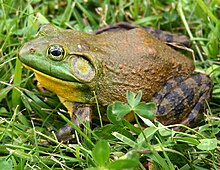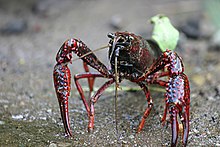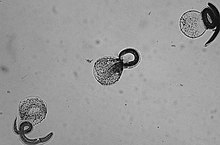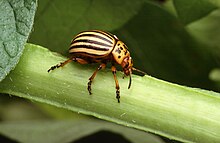List of neozoa in Germany
This article has been registered in the quality assurance biology for improvement due to formal or content-related deficiencies . This is done in order to bring the quality of the biology articles to an acceptable level. Please help improve this article! Articles that are not significantly improved can be deleted if necessary.
Read the more detailed information in the minimum requirements for biology articles .
The list of neozoa in Germany lists neozoa that have established themselves in Germany .
overview
There are at least 1,100 alien animal species in Germany. Of these, however, only about 260 species are considered established, including 30 vertebrate species.
| Species group | Species number | established | not yet established | Status questionable |
|---|---|---|---|---|
| Mammals | 22nd | 8th | 14th | 0 |
| Birds | 163 | 15th | 138 | 10 |
| Reptiles | 14th | 0 | 13 | 1 |
| Amphibians | 8th | 1 | 7th | 0 |
| Bony fish | 54 | 8th | 21st | 25th |
| Arachnids | 35 | 10 | 2 | 23 |
| insects | 553 | 115 | 185 | 253 |
| Crustaceans | 62 | 26th | 9 | 27 |
| Annelid worms | 33 | 10 | 4th | 19th |
| other articulated animals | 20th | 7th | 12 | 1 |
| Molluscs | 83 | 40 | 7th | 36 |
| Roundworms | 25th | 4th | 10 | 11 |
| Flatworms | 36 | 8th | 8th | 20th |
| Cnidarians | 7th | 5 | 1 | 1 |
| Unicellular organisms | 21st | 3 | 8th | 10 |
| other species | 13 | 4th | 4th | 5 |
| total | 1149 | 264 | 443 | 442 |
Source: Federal Agency for Nature Conservation (BfN), status: 2008
listing













(The original distribution areas are in brackets after the scientific name of the animal species.)
The list does not claim to be complete. Since these are dynamic processes, determining whether a population is established is sometimes difficult.
Mammals
- Siberian chipmunk ( Burunduk ), Tamias sibiricus (North America, Asia)
- Nutria , Myocastor coypus (South America)
- Muskrat , Ondatra zibethicus (North America)
- American mink (Mink), Mustela vison (North America)
- Raccoon dog , Nyctereutes procyonoides (Eastern Siberia, China, Japan)
- Raccoon , Procyon lotor (North America)
- Wild rabbit , Oryctolagus cuniculus (Iberian Peninsula)
- Fallow deer , Dama dama (Mesopotamia)
- Sika deer , Cervus nippon (Eastern China, Siberia, Korea, Japan, Taiwan)
- European mouflon , Ovis ammon musimon (Sardinia, Corsica)
- Brown rat , Rattus norvegicus (Central Asia, North China)
Birds
- Nandu , Rhea americana (pampas grasslands of South America, Argentina, Paraguay, Brazil)
- Chileflamingo , Phoenicopterus chilensis (South America)
- Cuban flamingo , Phoenicopterus ruber ruber (Caribbean and Galapagos Islands)
- Swan Goose , Anser cygnoid (Siberia, China, Mongolia)
- Bar-headed Goose , Anser indicus (India, Himalayas, to Mongolia and southern Russia)
- Canada goose , Branta canadensis (North America)
- Egyptian goose , Alopochen aegyptiacus (East Africa, Balkans)
- Rusty goose , Tadorna ferruginea (Inner Asian steppes)
- Mandarin duck , Aix galericulata (Northeast China, Amur Region, Japan)
- Wood Duck , Aix sponsa (North America)
- Ruddy Duck , Oxyura jamaicensis (North America)
- Wild turkey , Meleagris gallopavo (North America)
- Hunting Pheasant , Phasianus colchicus (Central Asia)
- King Pheasant , Syrmaticus reevesi (China)
- Cattle Egret , Bubulcus ibis (Africa without the Sahara, Arabian Peninsula, Iberian Peninsula)
- Yellow-headed Parrot , Amazona oratrix (Central America, so far only an established occurrence in the Stuttgart area)
- Ring-necked Parakeet , Psittacula krameri (from East Africa to India)
- Greater Alexander Parakeet , Psittacula eupatria (Middle East to Southeast Asia)
Amphibians
- American bullfrog , Rana catesbeiana (North America)
Bony fish
- Guppy , Poecilia reticulata (South America, Amazon Basin)
- Blue banded harlequin , Pseudorasbora parva (East Asia)
- Dwarf or catfish , Ameiurus nebulosus (North America)
- Small dogfish , Umbra pygmaea (North America)
- Rainbow trout , Oncorhynchus mykiss (northwestern North America)
- Brook char , Salvelinus fontinalis (Asia and North America)
- Common bluegill , Lepomis gibbosus (North America)
- Green sunfish , Lepomis cyanellus (North America)
- Largemouth bass , Micropterus salmoides (North America)
- Goldfish , Carassius gibelio forma auratus (domesticated form of the Asian gable, Eastern China)
- Silver carp , Hypophthalmichthys molitrix (Central China, Amur region)
- Black pygmy catfish , Ameiurus melas (Midwestern USA, Southern Canada)
- Koboldkärpfling , Gambusia affinis (Central North America)
- Grass carp , Ctenopharyngodon idella (China)
- Marble carp , Hypophthalmichthys nobilis (river systems in southern China)
- Black-mouthed goby , Neogobius melanostomus ( Pontokaspis )
Arachnids
- Varroa mite , Varroa destructor (was introduced from East Asia due to its parasitic way of life with Asian bees)
- Alluvial forest tick , Dermacentor reticulatus (Southern Europe)
- Brown dog tick , Rhipicephalus sanguineus (Africa)
- Zoropsis spinimana , (European Mediterranean)
Crustaceans
- Chinese mitten crab , Eriocheir sinensis (Korean Peninsula and Eastern China)
- Atyaephyra desmaresti (family Atyidae ), (Mediterranean region)
- Calico cancer , Orconectes immunis (Mississippi and tributaries, USA)
- Crayfish , Orconectes limosus (North America)
- Red American crayfish , Procambarus clarkii (Louisiana, USA)
- Marble Crab , Procambarus spec. (presumably southern North America)
- Signal Crab , Pacifastacus leniusculus (Eastern USA)
- Zuiderzeekrabbe , Rhithropanopeus harrisii (east coast of North America)
- Limnomysis benedeni (Pontocaspis)
- Mud shrimp , Corophium volutator (Pontokaspis)
- Great humpback shrimp , Dikerogammarus villosus (Pontokaspis)
- Galician crayfish , Astacus leptodactylus (Pontokaspis)
- Freshwater tube crayfish , Chelicorophium curvispinum (Pontokaspis)
- Blue crab , Callinectes sapidus (Atlantic coast of North and South America)
- Asiatic sea crab square crab , Hemigrapsus sanguineus (western Pacific)
- Portumnus latipes , (Mediterranean region)
Molluscs
- Wandering mussel , Dreissena polymorpha (Black Sea, Danube Delta)
- Quagga clam , Dreissena rostriformis bugensis (Black Sea estuaries)
- Coarsely ribbed cup mussel , Corbicula fluminea (China, Taiwan)
- Finely ribbed cup mussel , Corbicula fluminalis (China. Taiwan)
- New Zealand lid snail , Potamopyrgus antipodarum (New Zealand)
- Marine coral , Teredo navalis (tropical and subtropical seas, favored by climate change)
- Slipper shell , Crepidula fornicata (Gulf of Mexico, Atlantic and Pacific coast of North America)
- Pointed bladder snail , Physella acuta (Africa, Southern Europe)
- American bladder snail , Physella heterostropha (North America)
- Pacific rock oyster , Crassostrea gigas (East Asia)
- American sheath clam , Ensis directus (North America)
- American post squirrel , Gyraulus parvus (North America)
- Chinese pond mussel , Sinanodonta woodiana (Southeast Asia)
- Sand Gap Mussel , Mya arenaria (North America)
- American drill mussel , Petricola pholadiformis (east coast of North America)
- Coniferous crown snail , Melanoides tuberculata (East Africa to Southeast Asia)
- Spanish slug , Arion vulgaris (unclear, probably southwest France)
- Rapana venosa (Western Pacific, Black Sea)
insects
- Cherry vinegar fly , Drosophila suzukii (Southeast Asia)
- Amber wood cockroach , Ectobius vittiventris (Southern Europe)
- Oriental wall wasp , Sceliphron curvatum (India)
- Yellow-footed ground termites , Reticulitermes flavipes (Eastern North America)
- Box tree moth , Cydalima perspectalis (East Asia)
- American cockroach , Periplaneta americana (probably South Asia )
- American pine bug , Leptoglossus occidentalis (western North America)
- Blue Pelargonium , Cacyreus marshalli (southern Africa)
- Asian ladybird , Harmonia axyridis (China, Japan)
- Horse chestnut leaf miner , Cameraria ohridella (first discovered in Macedonia)
- Colorado potato beetle , Leptinotarsa decemlineata (Colorado, USA)
- Asian longhorn beetle , Anoplophora glabripennis (East Asia)
- Longhorn beetle , Anoplophora chinensis (Southeast Asia)
- Phylloxera , Viteus vitifoliae (North America)
- Pharaoh ant , Monomorium pharaonis (East India)
- Hypoponera punctatissima , (species of ant from the tropics)
- Sycamore net bug , Corythucha ciliata (North America)
- American buffalo treehopper , Stictocephala bisonia (North America)
- Robinia miner moth , Phyllonorycter robiniella (was introduced from North America with the neophyte, the black locust ( Robinia pseudoacacia ))
- Asiatic bush mosquito , Aedes (Hulecoeteomyia) japonicus syn. Hulecoeteomyia japonica (East Asia)
- Korean bush mosquito , Aedes [Hulecoeteomyia] koreicus syn. Aedes [Finlaya] koreicus , originally Ochlerotatus koreicus (Northeast Asia)
- European silver fir tree , Dreyfusia nordmannianae (Caucasus, Crimean Peninsula)
- Greenhouse whitefly , Trialeurodes vaporariorum (presumably Central America)
- California flower thrips , Frankliniella occidentalis (Southwest USA)
- Western corn rootworm , Diabrotica virgifera (Central America)
- Japanese chestnut gall wasp , Dryocosmus kuriphilus (introduced from southern China via Japan to Europe)
- Walnut fruit fly , Rhagoletis completa (introduced from North America)
- Zigzag sawfly , Aproceros leucopoda (introduced from East Asia)
worms
- Freshwater bristle worm , Hypania invalida (Pontokaspis)
- Gill worm , Branchiura sowerbyi (Southeast Asia)
- Spotted strudelworm , also tiger planaria or tiger strudelwurm, Dugesia tigrina (North America)
- Raccoon roundworm , Baylisascaris procyonis (introduced as a parasite with the raccoon from North America)
- Gold nematode , Globodera rostochiensis (Was introduced from South America with the potato )
- Swim bladder worm , Anguillicoloides crassus (infects river eels and originally came from East Asia)
Cnidarians
- Freshwater jellyfish , Craspedacusta sowerbii (East Asia)
- Sea walnut , Mnemiopsis Leidyi (Subtropical Atlantic coasts of North and South America)
- Club polyp , Cordylophora caspia (Pontokaspis)
Single-celled animals
- Babesia canis canis , (a babesiosis pathogen in dogs , is transmitted by the introduced alluvial forest tick )
Other animals
- Sponge-like bogfish , Pectinatella magnifica (North America)
- African freshwater sponge , Eunapius carteri (Africa, Middle East, India)
- Spider Runner , Scutigera coleoptrata (Mediterranean, Italy, Spain, Balkans)
See also
literature
- Robert Hofrichter: The return of the wild animals. Wolf, Geier, Elch & Co. Stocker, Stuttgart / Graz 2005, ISBN 3-7020-1059-9 .
Web links
Individual evidence
- ↑ Alien species ( Memento of the original from January 5, 2016 in the Internet Archive ) Info: The archive link was inserted automatically and has not yet been checked. Please check the original and archive link according to the instructions and then remove this notice. at bfn.de, accessed on January 5, 2016.
- ^ Frank Klingenstein, Paul M. Kornacker, Harald Martens, Uwe Schippmann (2005): Alien species. Position paper of the Federal Agency for Nature Conservation . BfN scripts 128: 15.
- ↑ Inventory and evaluation of neozoa in Germany (2011)
- ^ Sibylle Münch: Burunduk. In: Monika Braun, Fritz Dieterlen (Hrsg.): Die Säugetiere Baden-Württemberg. Volume 2. Eugen Ulmer Verlag, 2005, ISBN 3-8001-4246-5 .
- ↑ a b c d e f g h Olaf Geiter, Susanne Homma, Ragnar Kinzelbach: Inventory and assessment of neozoa in Germany In: Federal Environment Agency. Texts. 25/02, 2002, ISSN 0722-186X , umweltbundesamt.de (PDF, 3.17 MB).
- ↑ a b c d e f g h i j k l m n o p q r s t u v w x y z aa from Stephan Gollasch, Stefan Nehring: National checklist for aquatic alien species in Germany. In: Aquatic Invasions. Volume 1, No. 4. 2006, pp. 245-269. doi: 10.3391 / ai.2006.1.4.8 .
- ^ R. Riedl: Fauna and Flora of the Mediterranean Sea. Paul Parey, Hamburg / Berlin 1983, p. 499.
- ↑ Francis Kerckhof, Robert J.Vink, Dennis C. Nieweg, John NJ Post: The veined whelk Rapana Venosa has reached the North Sea. (PDF; 281 kB) In: Aquatic Invasions (2006) 1: pp. 35–37.
- ^ Pro-Planta
- ^ Blank, SM; Koehler, T .; Pfannenstill, T .; Neuenfeldt, N .; Zimmer, B .; Jansen, E .; Taeger, A .; Liston, AD: Zig-zagging across Central Europe: recent range extension, dispersal speed and larval hosts of Aproceros leucopoda (Hymenoptera, Argidae) in Germany. In: Journal of Hymenoptera Research . tape 41 , 2014, p. 57-74 .
- ^ Blank, SM; Hara, H .; Mikulás, J .; Csóka, G .; Ciornei, C .; Constantineanu, R .; Constantineanu, I .; Roller, L .; Altenhofer, E .; Huflejt, T .; Vétek, G .: Aproceros leucopoda (Hymenoptera, Argidae): An East Asian pest of elms (Ulmus spp.) Invading Europe. In: European Journal of Entomology . tape 107 , 2010, p. 357-367 .

